6.1: Polar Coordinates
( \newcommand{\kernel}{\mathrm{null}\,}\)
Learning Objectives
- Distinguish between and understand the difference between a rectangular coordinate system and a polar coordinate system.
- Plot points with polar coordinates on a polar plane.
Over 12 kilometers from port, a sailboat encounters rough weather and is blown off course by a 16-knot wind (see Figure 6.1.1). How can the sailor indicate his location to the Coast Guard? In this section, we will investigate a method of representing location that is different from a standard coordinate grid.
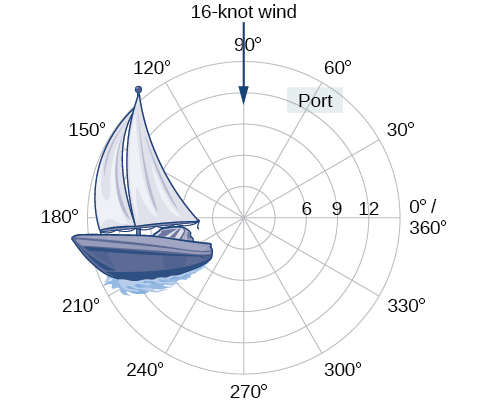
Plotting Points Using Polar Coordinates
When we think about plotting points in the plane, we usually think of rectangular coordinates (x,y) in the Cartesian coordinate plane. However, there are other ways of writing a coordinate pair and other types of grid systems. In this section, we introduce to polar coordinates, which are points labeled (r,θ) and plotted on a polar grid. The polar grid is represented as a series of concentric circles radiating out from the pole, or the origin of the coordinate plane.
The polar grid is scaled as the unit circle with the positive x-axis now viewed as the polar axis and the origin as the pole. The first coordinate r is the radius or length of the directed line segment from the pole. The angle θ, measured in radians, indicates the direction of r. We move counterclockwise from the polar axis by an angle of θ,and measure a directed line segment the length of r in the direction of θ. Even though we measure θ first and then r, the polar point is written with the r-coordinate first. For example, to plot the point (2,π4), we would move π4 units in the counterclockwise direction and then a length of 2 from the pole. This point is plotted on the grid in Figure 6.1.2.
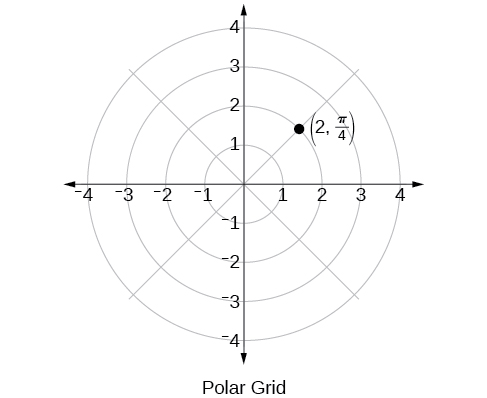
Example 6.1.1: Plotting a Point on the Polar Grid
Plot the point (3,π2) on the polar grid.
Solution
The angle π2 is found by sweeping in a counterclockwise direction 90° from the polar axis. The point is located at a length of 3 units from the pole in the π2 direction, as shown in Figure 6.1.3.
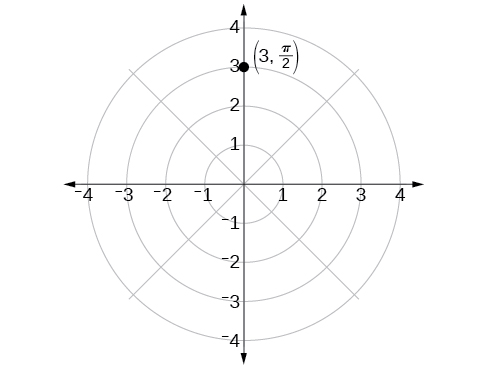
Exercise 6.1.1
Plot the point (2,π3) in the polar grid.
- Answer
-
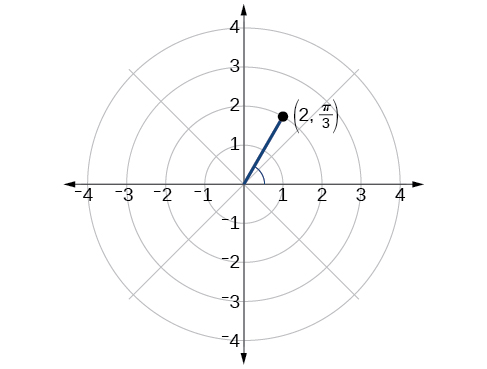
Figure 6.1.4
Example 6.1.2: Plotting a Point in the Polar Coordinate System with a Negative Component
Plot the point (−2,π6) on the polar grid.
Solution
We know that π6 is located in the first quadrant. However, r=−2. We can approach plotting a point with a negative r in two ways:
- Plot the point (2,π6) by moving π6 in the counterclockwise direction and extending a directed line segment 2 units into the first quadrant. Then retrace the directed line segment back through the pole, and continue 2 units into the third quadrant;
- Move π6 in the counterclockwise direction, and draw the directed line segment from the pole 2 units in the negative direction, into the third quadrant.
See Figure 6.1.5a. Compare this to the graph of the polar coordinate (2,π6) shown in Figure 6.1.5b.

Exercise 6.1.2
Plot the points (3,−π6) and (2,9π4) on the same polar grid.
- Answer
-
.jpg?revision=1)
Figure 6.1.6
Converting from Polar Coordinates to Rectangular Coordinates
When given a set of polar coordinates, we may need to convert them to rectangular coordinates. To do so, we can recall the relationships that exist among the variables x, y, r, and θ.
cosθ=xr→x=rcosθ
sinθ=yr→y=rsinθ
Dropping a perpendicular from the point in the plane to the x-axis forms a right triangle, as illustrated in Figure 6.1.7. An easy way to remember the equations above is to think of cosθ as the adjacent side over the hypotenuse and sinθ as the opposite side over the hypotenuse.
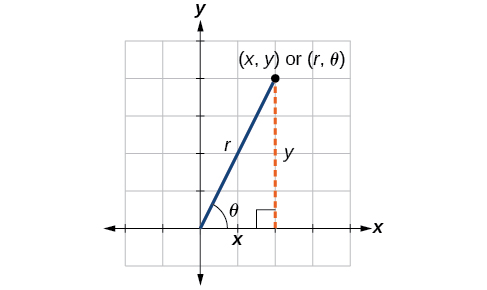
CONVERTING FROM POLAR COORDINATES TO RECTANGULAR COORDINATES
To convert polar coordinates (r,θ) to rectangular coordinates (x,y), let
cosθ=xr→x=rcosθ
sinθ=yr→y=rsinθ
How to: Given polar coordinates, convert to rectangular coordinates.
- Given the polar coordinate (r,θ), write x=rcosθ and y=rsinθ.
- Evaluate cosθ and sinθ.
- Multiply cosθ by r to find the x-coordinate of the rectangular form.
- Multiply sinθ by r to find the y-coordinate of the rectangular form.
Example 6.1.3A: Writing Polar Coordinates as Rectangular Coordinates
Write the polar coordinates (3,π2) as rectangular coordinates.
Solution
Use the equivalent relationships.
x=rcosθx=3cosπ2=0y=rsinθy=3sinπ2=3
The rectangular coordinates are (0,3). See Figure 6.1.8.
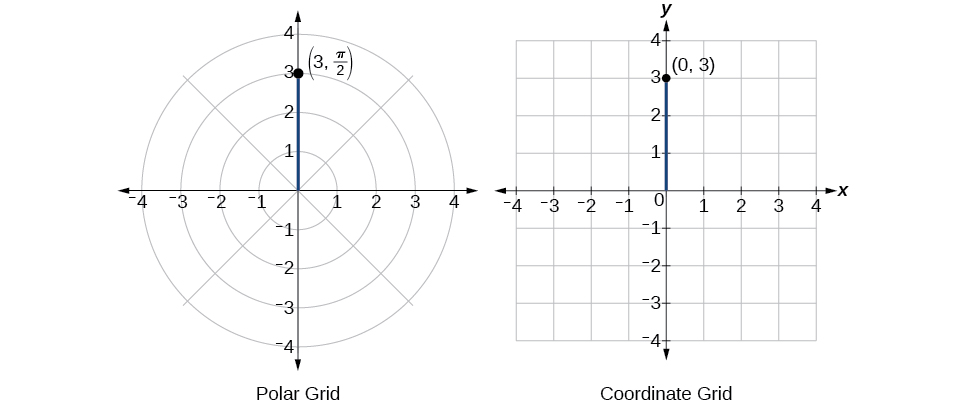
Example 6.1.3B: Writing Polar Coordinates as Rectangular Coordinates
Write the polar coordinates (−2,0) as rectangular coordinates.
Solution
See Figure 6.1.9. Writing the polar coordinates as rectangular, we have
x=rcosθx=−2cos(0)=−2y=rsinθy=−2sin(0)=0
The rectangular coordinates are also (−2,0).

Exercise 6.1.3
Write the polar coordinates (−1,2π3) as rectangular coordinates.
- Answer
-
(x,y)=(12,−√32)
Converting from Rectangular Coordinates to Polar Coordinates
To convert rectangular coordinates to polar coordinates, we will use two other familiar relationships. With this conversion, however, we need to be aware that a set of rectangular coordinates will yield more than one polar point.
CONVERTING FROM RECTANGULAR COORDINATES TO POLAR COORDINATES
Converting from rectangular coordinates to polar coordinates requires the use of one or more of the relationships illustrated in Figure 6.1.10.
cosθ=xr or x=rcosθ
sinθ=yr or y=rsinθ
r2=x2+y2
tanθ=yx
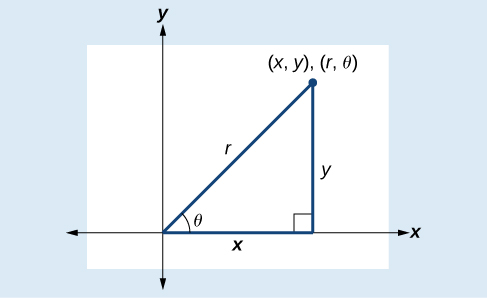
Example 6.1.4: Writing Rectangular Coordinates as Polar Coordinates
Convert the rectangular coordinates (3,3) to polar coordinates.
Solution
We see that the original point (3,3) is in the first quadrant. To find θ, use the formula tanθ=yx. This gives
tanθ=33tanθ=1tan−1(1)=π4
To find r, we substitute the values for x and y into the formula r=√x2+y2. We know that r must be positive, as π4 is in the first quadrant. Thus
r=√32+32r=√9+9r=√18=3√2
So, r=3√2 and θ=π4, giving us the polar point (3√2,π4). See Figure 6.1.11.

Analysis
There are other sets of polar coordinates that will be the same as our first solution. For example, the points (−3√2,5π4) and (3√2,−7π4) will coincide with the original solution of (3√2,π4). The point (−3√2,5π4) indicates a move further counterclockwise by π, which is directly opposite π4. The radius is expressed as −3√2. However, the angle 5π4 is located in the third quadrant and, as r is negative, we extend the directed line segment in the opposite direction, into the first quadrant. This is the same point as (3√2,π4). The point (3√2,−7π4) is a move further clockwise by −7π4, from π4. The radius, 3√2, is the same.
Extra Practice
- Plot the point with polar coordinates (3,π6).
- Plot the point with polar coordinates (5,−2π3)
- Convert (6,−3π4) to rectangular coordinates.
- Convert (−2,3π2) to rectangular coordinates.
- Convert (7,-2) to polar coordinates.
- Convert (-9,-4) to polar coordinates.
Key Equations
|
Conversion formulas |
cosθ=xr→x=rcosθ sinθ=yr→y=rsinθ r2=x2+y2 tanθ=yx |
Key Concepts
- The polar grid is represented as a series of concentric circles radiating out from the pole, or origin.
- To plot a point in the form (r,θ), θ>0, move in a counterclockwise direction from the polar axis by an angle of θ, and then extend a directed line segment from the pole the length of r in the direction of θ. If θ is negative, move in a clockwise direction, and extend a directed line segment the length of r in the direction of θ. See Example 6.1.1.
- If r is negative, extend the directed line segment in the opposite direction of θ. See Example 6.1.2.
- To convert from polar coordinates to rectangular coordinates, use the formulas x=rcosθ and y=rsinθ. See Example 6.1.3 and Example 6.1.4.
- To convert from rectangular coordinates to polar coordinates, use one or more of the formulas: cosθ=xr, sinθ=yr, tanθ=yx, and r=√x2+y2. See Example 6.1.5.
Contributors and Attributions
Jay Abramson (Arizona State University) with contributing authors. Textbook content produced by OpenStax College is licensed under a Creative Commons Attribution License 4.0 license. Download for free at https://openstax.org/details/books/precalculus.

